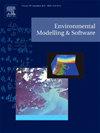Prediction of maximum scour depth downstream of bed sills using integrated machine learning algorithms
IF 4.6
2区 环境科学与生态学
Q1 COMPUTER SCIENCE, INTERDISCIPLINARY APPLICATIONS
引用次数: 0
Abstract
Accurate prediction of maximum relative scour depth (ys/Hs) is critical for hydraulic infrastructure resilience. This study advances scour depth prediction downstream of bed sills by establishing three ensemble models—Random Forest (RF), Gradient Boosting Decision Tree (GBDT), and XGBoost—trained on a comprehensive dataset combining 328 standardized flume experiments (clear-water and live-bed conditions) with 73 field measurements. Validation using 29 field datasets from Maso River reveals MAE reductions of 32.5 %, 28.7 %, and 30.2 % for RF, GBDT, and XGBoost, respectively, compared to laboratory-trained models, translating to at least 31.6 % higher accuracy than traditional empirical approaches. Comprehensive sensitivity analysis identifies four dimensionless parameters as critical predictors, ranked by their relative importance to scour development: morphological transition coefficient (a1/Hs) > sediment sorting coefficient (a1/ΔD95) > weir spacing ratio (L/Hs) > channel slope (S0). By integrating lab and field data, this approach enhances scour prediction accuracy for fluvial risk management.
利用集成机器学习算法预测河床下游最大冲刷深度
最大相对冲刷深度(ys/Hs)的准确预测是水利基础设施恢复能力的关键。本研究通过建立随机森林(random Forest, RF)、梯度增强决策树(Gradient Boosting Decision Tree, GBDT)和xgboost三种集成模型来推进河床下游冲刷深度预测,该模型在一个综合数据集上进行训练,该数据集结合了328个标准化水槽实验(清水和活床条件)和73个现场测量结果。使用来自Maso River的29个现场数据集进行验证表明,与实验室训练的模型相比,RF、GBDT和XGBoost的MAE分别降低了32.5%、28.7%和30.2%,比传统经验方法的准确率至少提高了31.6%。综合敏感性分析确定了四个无量纲参数作为关键预测因子,根据它们对冲刷发展的相对重要性进行排名:形态过渡系数(a1/Hs) >;泥沙分选系数(a1/ΔD95) >;堰距比(L/Hs) >;河道坡度(S0)。通过整合实验室和现场数据,该方法提高了河流风险管理的冲刷预测精度。
本文章由计算机程序翻译,如有差异,请以英文原文为准。
求助全文
约1分钟内获得全文
求助全文
来源期刊

Environmental Modelling & Software
工程技术-工程:环境
CiteScore
9.30
自引率
8.20%
发文量
241
审稿时长
60 days
期刊介绍:
Environmental Modelling & Software publishes contributions, in the form of research articles, reviews and short communications, on recent advances in environmental modelling and/or software. The aim is to improve our capacity to represent, understand, predict or manage the behaviour of environmental systems at all practical scales, and to communicate those improvements to a wide scientific and professional audience.
 求助内容:
求助内容: 应助结果提醒方式:
应助结果提醒方式:


